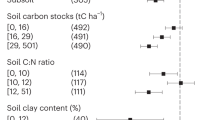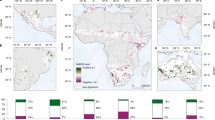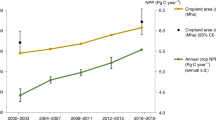Abstract
Pastures and rangelands underpin global meat and milk production and are a critical resource for millions of people dependent on livestock for food security1,2. Forage growth, which is highly climate dependent3,4, is potentially vulnerable to climate change, although precisely where and to what extent remains relatively unexplored. In this study, we assess climate-based threats to global pastures, with a specific focus on changes in within- and between-year precipitation variability (precipitation concentration index (PCI) and coefficient of variation of precipitation (CVP), respectively). Relating global satellite measures of vegetation greenness (such as the Normalized Difference Vegetation Index; NDVI) to key climatic factors reveals that CVP is a significant, yet often overlooked, constraint on vegetation productivity across global pastures. Using independent stocking data, we found that areas with high CVP support lower livestock densities than less-variable regions. Globally, pastures experience about a 25% greater year-to-year precipitation variation (CVP = 0.27) than the average global land surface area (0.21). Over the past century, CVP has generally increased across pasture areas, although both positive (49% of pasture area) and negative (31% of pasture area) trends exist. We identify regions in which livestock grazing is important for local food access and economies, and discuss the potential for pasture intensification in the context of long-term regional trends in precipitation variability.
This is a preview of subscription content, access via your institution
Access options
Access Nature and 54 other Nature Portfolio journals
Get Nature+, our best-value online-access subscription
$29.99 / 30 days
cancel any time
Subscribe to this journal
Receive 12 print issues and online access
$209.00 per year
only $17.42 per issue
Buy this article
- Purchase on Springer Link
- Instant access to full article PDF
Prices may be subject to local taxes which are calculated during checkout



Similar content being viewed by others
References
Galvin, K. A., Reid, R. S., Behnke, R. H. & Hobbs, N. T. Fragmentation in Semi-Arid and Arid Landscapes: Consequences for Human and Natural Systems (Springer: Amsterdam, 2018).
O’Mara, F. P. The role of grasslands in food security and climate change. Ann. Bot. 110, 1263–1270 (2012).
Campbell, B. D. & Stafford Smith, D. M. A synthesis of recent global change research on pasture and rangeland production: Reduced uncertainties and their management implications. Agric. Ecosyst. Environ. 82, 39–55 (2000).
Herrero, M. et al. Biomass use, production, feed efficiencies, and greenhouse gas emissions from global livestock systems. Proc. Natl Acad. Sci. USA 110, 20888–20893 (2013).
Foley, J. A. et al. Solutions for a cultivated planet. Nature 478, 337–342 (2011).
Allred, B. W., Scasta, J. D., Hovick, T. J., Fuhlendorf, S. D. & Hamilton, R. G. Spatial heterogeneity stabilizes livestock productivity in a changing climate. Agric. Ecosyst. Environ. 193, 37–41 (2014).
Ellis, J. E. & Swift, D. M. Stability of African pastoral ecosystems: alternate paradigms and implications for development. J. Range Manag. 41, 450–459 (1988).
Briske, D. D., Fuhlendorf, S. D. & Smeins, F. E. Vegetation dynamics on rangelands: a critique of the current paradigms. J. Appl. Ecol. 40, 601–614 (2003).
Illius, A. W. & O’Connor, T. G. On the relevance of nonequilibrium concepts to arid and semiarid grazing systems. Ecol. Appl. 9, 798–813 (1999).
Asner, G. P., Elmore, A. J., Olander, L. P., Martin, R. E. & Harris, A. T. Grazing systems, ecosystem responses, and global change. Annu. Rev. Environ. Resour. 29, 261–299 (2004).
IPCC Climate Change 2014: Synthesis Report (eds Core Writing Team, Pachauri, R. K. & Meyer L. A.) (IPCC, 2015).
Ellis, J. & Galvin, K. A. Climate patterns and land-use practices in the dry zones of Africa. Bioscience 44, 340–349 (1994).
Wehrden, H. Von, Hanspach, J., Kaczensky, P., Fischer, J. & Wesche, K. Global assessment of the non-equilibrium concept in rangelands. Ecol. Appl. 22, 393–399 (2012).
Le Houérou, H. N., Bingham, R. L. & Skerbek, W. Relationship between the variability of primary production and the variability of annual precipitation in world arid lands. J. Arid Environ. 15, 1–18 (1988).
Knapp, A. K., Harper, C. W., Danner, B. T. & Lett, M. S. Rainfall variability, carbon cycling, and plant species diversity in a mesic grassland. Science 298, 2202–2205 (2002).
Huxman, T. E. et al. Precipitation pulses and carbon fluxes in semiarid and arid ecosystems. Oecologia 141, 254–268 (2004).
Oliver, J. E. Monthly precipitation distribution: a comparative index. Prof. Geogr. 32, 300–309 (1980).
Sokol Jurkovic, R. & Zoran, P. Spatial variability of annual precipitation using globally gridded data sets from 1951 to 2000. Int. J. Climatol. 33, 690–698 (2013).
Fatichi, S., Ivanov, V. Y. & Caporali, E. Investigating interannual variability of precipitation at the global scale: is there a connection with seasonality? J. Clim. 25, 5512–5523 (2012).
Li, X., Jiang, F. & Wang, G. Spatial and temporal variability of precipitation concentration index, concentration degree and concentration period in Xinjiang, China. Int. J. Climatol. 31, 1679–1693 (2011).
Marengo, J. A., Tomasella, J., Soares, W. R., Alves, L. M. & Nobre, C. A. Extreme climatic events in the Amazon basin. Theor. Appl. Climatol. 107, 73–85 (2012).
Verburg, P. H., Ellis, E. C. & Letourneau, A. A global assessment of market accessibility and market influence for global environmental change studies. Environ. Res. Lett. 6, 34019 (2011).
Thornton, P. et al. Vulnerability, climate change and livestock—research opportunities and challenges for poverty alleviation. SAT eJournal 4, 1–23 (2007).
Jones, P. G. & Thornton, P. K. Croppers to livestock keepers: livelihood transitions to 2050 in Africa due to climate change. Environ. Sci. Policy 12, 427–437 (2009).
Dube, O. P. & Pickup, G. Effects of rainfall variability and communal and semi-commercial grazing on land cover in southern African rangelands. Clim. Res. 17, 195–208 (2001).
Cleverly, J. et al. The importance of interacting climate modes on Australia’s contribution to global carbon cycle extremes. Sci. Rep. 6, 23113 (2016).
Landsberg, R. G., Ash, A. J., Shepherd, R. K. & McKeon, G. M. Learning from history to survive in the future: management evolution on Trafalgar Station, north-east Queensland. Rangel. J. 20, 104–118 (1998).
Newsham, A. J. & Thomas, D. S. G. Knowing, farming and climate change adaptation in North–Central Namibia. Glob. Environ. Chang. 21, 761–770 (2011).
Mirzabaev, A., Ahmed, M., Werner, J., Pender, J. & Louhaichi, M. Rangelands of Central Asia: challenges and opportunities. J. Arid Land. 8, 93–108 (2016).
Harris, I., Jones, P. D., Osborn, T. J. & Lister, D. H. Updated high-resolution grids of monthly climatic observations—the CRU TS3.10 Dataset. Int. J. Climatol. 34, 623–642 (2014).
Koutsouris, A. J., Chen, D. & Lyon, S. W. Comparing global precipitation data sets in eastern Africa: a case study of Kilombero Valley, Tanzania. Int. J. Energy 36, 2000–2014 (2016).
Becker, A. et al. A description of the global land-surface precipitation data products of the Global Precipitation Climatology Centre with sample applications including centennial (trend) analysis from 1901–present. Earth Syst. Sci. Data 5, 71–99 (2013).
Legates, D. R. & Willmott, C. J.. Mean seasonal and spatial variability in gauge‐corrected, global precipitation. Int. J. Climatol. 10, 111–127 (1990).
Ramankutty, N., Evan, A. T., Monfreda, C. & Foley, J. A. Farming the planet: 1. Geographic distribution of global agricultural lands in the year 2000. Global Biogeochem. Cycles 22, 1003 (2008).
Robinson, T. P. et al. Global Livestock Production Systems (Food and Agriculture Organization of the United Nations FAO, Rome, 2011).
Zeng, F. W., James Collatz, G., Pinzon, J. E. & Ivanoff, A. Evaluating and quantifying the climate-driven interannual variability in global inventory modeling and mapping studies (GIMMS) normalized difference vegetation index (NDVI3g) at global scales. Remote Sens. 5, 3918–3950 (2013).
Fensholt, R., Nielsen, T. T. & Stisen, S. Evaluation of AVHRR PAL and GIMMS 10‐day composite NDVI time series products using SPOT‐4 vegetation data for the African continent. Int. J. Remote Sens. 27, 2719–2733 (2006).
Fensholt, R. & Rasmussen, K. Analysis of trends in the Sahelian ‘rain-use efficiency’ using GIMMS NDVI, RFE and GPCP rainfall data. Remote Sens. Environ. 115, 438–451 (2011).
Fensholt, R., Rasmussen, K., Nielsen, T. T. & Mbow, C. Evaluation of earth observation based long term vegetation trends—intercomparing NDVI time series trend analysis consistency of Sahel from AVHRR GIMMS, Terra MODIS and SPOT VGT data. Remote Sens. Environ. 113, 1886–1898 (2009).
Prince, S. D. Satellite remote sensing of primary production: comparison of results for Sahelian grasslands 1981–1988. Int. J. Remote Sens. 12, 1301–1311 (1991).
Groten, S. M. E. NDVI—crop monitoring and early yield assessment of Burkina Faso. Int. J. Remote Sens. 14, 1495–1515 (1993).
Box, E. O., Holben, B. N. & Kalb, V. Accuracy of the AVHRR vegetation index as a predictor of biomass, primary productivity and net CO2 flux. Vegetatio 80, 71–89 (1989).
Press, W. H., Teukolsky, S. A, Vetterling, W. T &; Flannery, B. P. Numerical Recipes: The Art of Scientific Computing 3rd edn (Cambridge University Press, Cambridge, 2007).
Barton, K. Package ‘MuMIn’ v.1.40.0 (2015).
Acknowledgements
L.L.S., L.H.S., J.S.G., P.C.W. and L.G.F. acknowledge the support from the Gordon and Betty Moore Foundation. M.H. and C.G. acknowledge support from the CSIRO Science Leaders Programme. J.S.G., P.C.W. and M.H. were supported by the Belmont Forum/FACCE-JPI funded DEVIL project (Delivering Food Security from Limited Land) (NE/M021327/1) via NSF award no. 1540195. L.L.S. thanks the Early Career Cross-Disciplinary Writing Group.
Author information
Authors and Affiliations
Contributions
L.L.S., L.H.S., J.S.G. and P.C.W. conceived the idea of the study; W.K.S. and L.G.F. contributed to the remote sensing analysis; J.S.G. helped with coding and analysis; M.H. contributed with livestock density data and grazing concepts; C.G. and L.H.S. helped with the literature review; L.L.S. analysed the data and wrote the manuscript. All the authors contributed to the discussions and writing or revision of the manuscript.
Corresponding author
Additional information
Publisher’s note: Springer Nature remains neutral with regard to jurisdictional claims in published maps and institutional affiliations.
Supplementary information
Supplementary Information
Supplementary Figures 1–12 and Supplementary Table 1
Rights and permissions
About this article
Cite this article
Sloat, L.L., Gerber, J.S., Samberg, L.H. et al. Increasing importance of precipitation variability on global livestock grazing lands. Nature Clim Change 8, 214–218 (2018). https://doi.org/10.1038/s41558-018-0081-5
Received:
Accepted:
Published:
Issue Date:
DOI: https://doi.org/10.1038/s41558-018-0081-5
This article is cited by
-
Unequal impact of climate warming on meat yields of global cattle farming
Communications Earth & Environment (2024)
-
Future drought risk and adaptation of pastoralism in Eurasian rangelands
npj Climate and Atmospheric Science (2024)
-
Heterogeneity and non-linearity of ecosystem responses to climate change in the Qilian Mountains National Park, China
Journal of Arid Land (2023)
-
Overgrazing leads to decoupling of precipitation patterns and ecosystem carbon exchange in the desert steppe through changing community composition
Plant and Soil (2023)
-
Responses of grassland productivity to mowing intensity and precipitation variability in a temperate steppe
Oecologia (2023)



